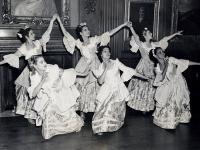Answer: Pennsylvania Ballet
This year marks the 50th anniversary of Pennsylvania Ballet, which was founded in 1963 by Barbara Weisberger, a protégé of George Balanchine. The ballet’s history began a year earlier when Weisberger established the School of Pennsylvania Ballet to train dancers for the company. Pennsylvania Ballet held its first local performance in the spring of 1964 at the Irvine Auditorium of the University of Pennsylvania. The ballet made national headlines a few years later in 1968 when it performed at City Center in New York City. Since then, the ballet has performed and forged relationships with other companies across the country and has performed on television, most notably in PBS’s Dance in America series.
Famed choreographer and co-founder of the New York City Ballet George Balanchine served as Pennsylvania Ballet’s first artistic advisor. Between 1972 and 1994, the company was overseen by three different artistic directors, Benjamin Harkarvy, Robert Weiss, and Chrisopher d’Amboise. In 1994, Roy Kaiser became the ballet’s first artistic director to have come up through its ranks as a dancer.
Pennsylvania Ballet currently consists of 48 dancers and performs regularly at the Academy of Music and the Merriam Theater. It also boasts a pre-professional training program called Pennsylvania Ballet II and continues to build its integrity while pushing the limits of creative freedom. The ballet is currently in the midst of a capital campaign project to raise funds for its new administrative, training, and rehearsal facility, the Louise Reed Center for Dance, which is located at Broad and Wood Streets on the Avenue of the Arts. The ballet will celebrate its 50th anniversary all season long, with special performances, exhibits, and speaker series throughout the city. For more information about the company, visit paballet.org.
The HSP Academy of Music collection (#3150) contains some programs from the Pennsylvania Ballet, as well as many from other local, regional, and national dance and theatre organizations. Additional images of ballet dancers are available in the Philadelphia Record photograph morgue (#V07).
Image: Littlefield Ballet, photograph (1937), Philadelphia Record photograph morgue

